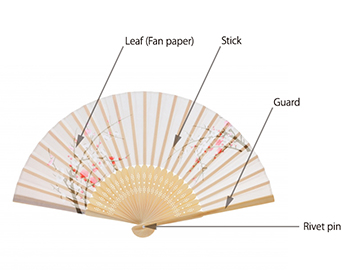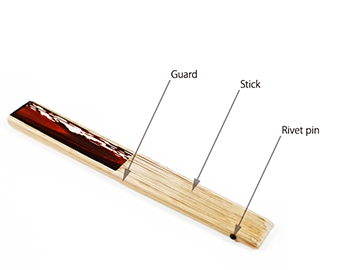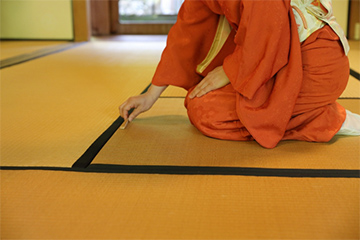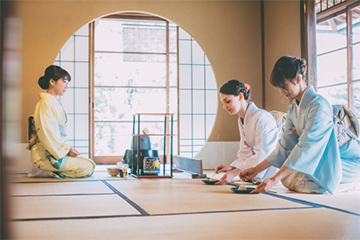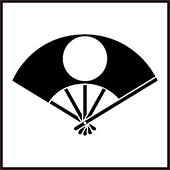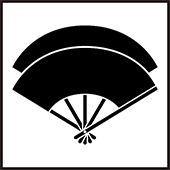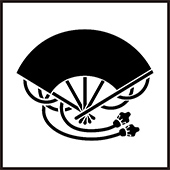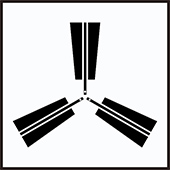Web Japan > Trends in Japan > Fashion&Design > Light and Compact Sensu Produce a Cool Breeze and are Used to Dance Gracefully or as a Rakugo Prop
Light and Compact Sensu Produce a Cool Breeze and are Used to Dance Gracefully or as a Rakugo Prop

Sensu (folding fans) are useful objects—you can slip them into your pocket on a hot summer’s day, and pull them out to enjoy a refreshing cool breeze when travelling outside.
Sensu are based on flat hand fans (Uchiwa) and are skillfully designed to fold up while still being able to deliver gusts of wind. They fold into a long and thin shape, making them easy to carry with you.
Flat hand fans have existed in China and Europe since antiquity, but it is said that Sensu were invented in Japan as an foldable, evolved form of these fans between the 6th and 9th centuries.
Sensu were not only used for people to fan themselves; they were familiar objects to many people in many ways. They have been offered as gifts with Japanese poetry written on them, they have been used in ceremonies and performing arts, and they have been exchanged as presents. In the present day, they are highly popular as souvenirs brought from Japan to overseas.
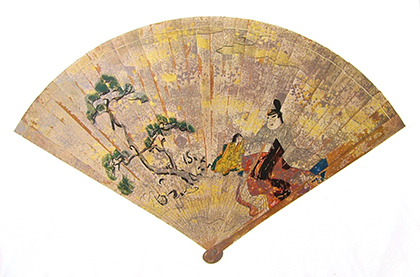
An early Sensu. This Sensu is called a “cypress fan” as it is made with thin blades made from cypress stitched together with string (late Heian Period (794–1192), housed at Itsukushima Shrine)
A Strong yet Light Structure Made from Bamboo and Paper
Sensu are generally made from bamboo and paper or from wood and paper.
The parts made from bamboo or wood are called the “sticks,” and the paper part is called the “leaf” or “fan paper.”
Anywhere from a handful to several dozen of the long, thin sticks are stacked on top of each other, a hole is made to pass through all of the sticks at one end, and then a part called a “rivet pin” is passed through this hole to fasten the sticks together. Finally, the sticks are spread out like the spokes of a wheel with the rivet pin in the center, and the fan paper is pasted onto the sticks to create a Sensu. Fan paper features sheets decorated with many different patterns.
The outermost thick sticks are called “guards.” Right-handed people can open up Sensu by holding the rivet pin in their right hand and pushing one guard with their thumb to shift it away. There are also Sensu made for left-handed people. Southpaws can open up these Sensu with the thumb on their left hand.
You can also unfold Sensu through the momentum of swinging them down while only holding the guard.
Sensu are Used for Greetings in the Tea Ceremony
Apart from being used in daily life, Sensu also appear in many areas of Japanese traditional culture.
When people greet each other while sitting in the formal Seiza position on tatami mats during the tea ceremony, they use these fans to divide the area between each person. The tea ceremony involves heating water to boil, steeping green tea, and serving it according to traditional Japanese methods and conventions. When participating as a guest in the tea ceremony, you must carry a Sensu with you, but you must not use it to fan yourself during the ceremony.
Classical Japanese Dance and Kabuki Feature Special Mai-ogi to Create Elegant Dances
Classical Japanese dance and Kabuki often use special Sensu called Mai-ogi. These fans always have 10 sticks, and the parts around the rivet pin have lead weights embedded in them to make the Mai-ogi easy to throw and spin.
Performers put these fans in front of them when greeting other people, just like in the tea ceremony. However, Mai-ogi also play a prominent role during dances. The fans are not only used to produce elegant movements as they are swung and turned over; they also express emotion and represent physical objects.
Sensu can be opened up and moved back and forth in a large motion while being carried through the air in elegant wave-like movements to represent a shower of cherry blossom petals falling. These fans can also be held in different ways to represent umbrellas, books, pine trees, or other objects.
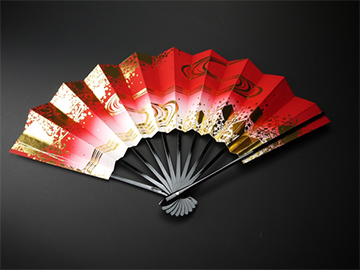
Mai-ogi are used in classical Japanese dance and Kabuki. Fans with colorful patterns are often used as room decorations
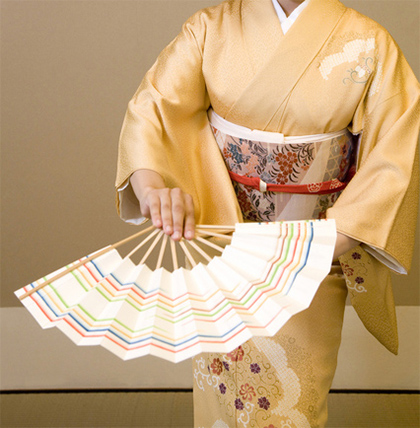
The fans are used in classical Japanese dance to create elegant expressions of emotion and sentiment. The image on the right is “Jo no Mai,” (designated as an Important Cultural Property) a picture showing a woman engaged in classical Japanese dance (by Shoen Uemura in 1936, and housed at Tokyo University of the Arts)
The Fans Feature as Props in Rakugo and Mimic Instruments in Kodan
Rakugo is a traditional narrative art in Japan where the performer sits alone in the formal Seiza position while delivering a humorous story centered on dialog. Rakugo performances only use two props: a Sensu and a hand towel. Performers use their Sensu and hand towel to represent all kinds of objects.
A folded-up Sensu can be used to mimic long, thin objects like chopsticks, writing brushes, or pipes. The performers use their eyes to create the impression of longer stick-like objects such as oars for rowing boats, scaffolding, or fishing rods. They open up the Sensu to make it resemble a written letter or a torch, and they open it halfway when acting out a phone conversation.
Scenes where characters eat soba or udon noodles give Rakugo performers the opportunity to demonstrate their skills. Holding their Sensu like chopsticks, they lift the noodles up high with one hand and pretend to hold the bowl in their other hand, blowing on the hot noodles to cool them and making slurping noises to give the impression that they have real noodles in front of them.
Kodan is another kind of narrative art featuring stories like Rakugo. However, unlike Rakugo, it is performed by reading out war chronicles or other written works related to history, and does not focus on depicting daily life through dialog. Kodan features a type of Sensu called Hari-ogi. This fan is used to make noises by hitting it on a table. It is prepared by wrapping Japanese paper around a folded Sensu, and so it cannot be opened up. Performers use Hari-ogi to emphasize the rhythm of their speech and to produce sound effects as they talk. In this way, the fan is used like a rhythm instrument that is played in a movie score. As the story draws to a climax, the performer makes more rapid, vigorous noises with the Hari-ogi to bring excitement and tension to the audience.
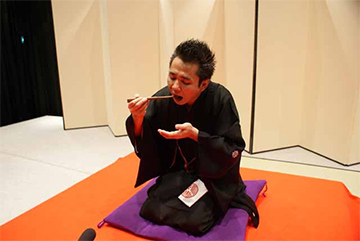
The Rakugo master Sanyutei Zenraku acts out eating with chopsticks (Photo provided by Mynavi News)
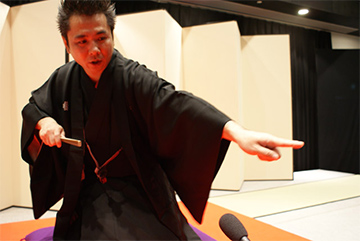
He stretches out his left hand and uses his eyes to express the length and power of a spear (Photo provided by Mynavi News)
Fans are Also Used in Kamon Designs as They Ward Off Evil and Bring Good Luck
Owing to their distinctive shape and the beauty of the design on the fan paper, Sensu are often used in decorations and as design elements. They are also used in Kamon. Kamon are crests used to represent a family line or lineage, and they incorporate uniquely Japanese design features. These crests are still used today for ceremonies, gravestones, and roof tiles.
In antiquity, people in Japan believed that spirits lived in fans, and so they used Sensu to ward off evil. People also believed that fans bring good luck because the shape of the fan paper growing wider as it extends from the rivet pin is a sign of new developments in the future. It is said that these reasons contributed to Sensu commonly featuring in Kamon.
Kamon featuring opened Sensu
Kamon featuring folded Sensu
A Wide Variety of Uses Built Up Over Many Years of History
At first glance, Sensu seem to only be for opening up and giving a cool breeze. However, people have conceived of many different uses for the fans over many years. In traditional arts, Sensu create a diverse range of expression for conveying human sentiment without any other props or stage devices.
Why not take a Sensu yourself to dance with elegance, to bring rhythm to your speech, or to act out novel gestures?

